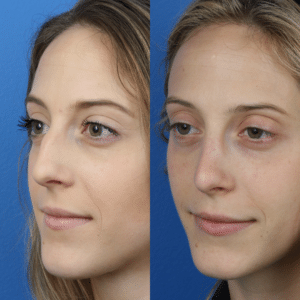How Does Rhinoplasty Affect My Facial Features?

What Rhinoplasty Will Change
Rhinoplasty surgery focuses on the cosmetic and functional aspects of the nose, though the vast majority of patients seek the procedure for purely aesthetic reasons. Even so, being dissatisfied with your nose does not always mean you’re also dissatisfied with your other features, such as your eyes, cheeks, and lips. Yet, many rhinoplasty patients appear to have a completely different look after surgery, so it’s easy to make the assumption that it’s not just the nose that is affected surgically.
In reality, rhinoplasty surgery is exclusively performed on the nasal structure, internal and/or external, unless the patient and facial plastic surgeon have agreed to include additional facial surgeries such as a chin augmentation or facelift. The surgery will chance the shape, projection, appearance, size, or some combination of these elements to achieve the desired result. Your eyes, lips, cheeks, and chin will all remain structurally the same.
Why Your Nose Can Change Everything
As mentioned, many patients wonder why changing the nose can have such a dramatic impact on the surrounding nasal features and even the overall aesthetic of the face. Consider that the nose is the central feature of the human face, a sole structure that extends forward from the cheeks, forehead, and jaw to add dimension and definition. From the side, a nose can give the profile its shape and structure, setting the tone for how the rest of the facial features will fit together.
Given this important positioning, the nose can make or break the facial harmony of any man or woman. With a nose too big or small, too crooked or straight, too hooked or flat, the entire perception of the face will change. Altering the nose through rhinoplasty will typically help the other facial features to get noticed, now that facial balance and harmony have been restored. By working with facial plastic surgeon Dr. Miller in New York City, achieving the overall look you want could be as simple as one surgery.
How Rhinoplasty Surgery is Performed
The rhinoplasty procedure can be performed using two different types of incision patterns: open or closed. In a closed rhinoplasty, the incisions are located inside the nostrils and leave behind no visible scarring externally. The range of access is a bit limited with this approach, so it is less often performed. In an open rhinoplasty, on the other hand, an additional incision is placed between the nostrils on the underside of the nose, allowing better access to the nasal tip, lower and middle third areas of the nose. The approach your facial plastic surgeon will use varies greatly on what changes you are looking to achieve through your surgery. Discuss your concerns and personal desires for surgery with your surgeon during a one on one rhinoplasty consultation to get started with the planning of your procedure.
Plan your Rhinoplasty Surgery with New York’s Top Plastic Surgeon
To learn more about rhinoplasty surgery and what it could achieve for you, read our nose job guide and then speak with the right facial plastic surgeon today. He can provide more in-depth knowledge about the nasal surgery process. Dr. Philip Miller has specialized exclusively in facial plastic surgery, offering over 20 years of experience and knowledge to his patients.
A recognized expert in rhinoplasty in New York, Dr. Miller has been frequently invited to share his specific techniques with his peers at various national facial plastic surgery meetings. He has been voted among the Best Doctors in America each year since 2007 and has also been named a Top Doctor of New York. To schedule a consultation with Dr. Miller, contact his office located at 60 East 56th Street, Third Floor in New York City, by calling (646) 791-3025.
Can Buccal Fat Removal Enhance Your Facelift Results?

What Is Buccal Fat?
Have you ever been told you have a round face, chipmunk cheeks, or a baby face? Plump lower cheeks are typically inherited as a genetic feature and not related to your weight. As a result, the buccal fat responsible for creating these rounded cheeks cannot be reduced through diet and exercise. Buccal fat can be frustrating and affect a patient’s aesthetic facial silhouette in a negative way. By removing buccal fat from the checks and lower face, you facial plastic surgeon can provide a slimmer, smoother profile and contour. For many men and women, addressing these excess fatty deposits can actually help to restore a patient’s youthful appearance.
Could Buccal Fat Removal Benefit You?
In order to qualify for buccal fat removal or any facial surgery, you should be in good physical health, be a nonsmoker, and have a realistic expectation for your final results. To specifically qualify for buccal fat removal, you should also have excessive fullness in the area around the lower cheeks. Men and women of nearly any age can benefit from this procedure.
How Can Buccal Fat Removal Enhance Facelift Results?
During your facelift surgery, your facial plastic surgeon will focus on tightening and smoothing the area of the lower face by addressing issues with the skin, fat cells, and underlying tissues. He will aim to create a better contour to your profile, with a refined silhouette of the chin, jaw, and neck. For patients with buccal fat in the lower cheeks, this smoothened contour will be hard to achieve without addressing it. After all, a refined chin and jaw may seem unnatural when compared to the remaining puffiness of the lower cheeks as a result of buccal fat.
Buccal fat removal can be paired with your facelift surgery to help reduce the presence of excess fatty deposits in the lower cheeks. With this fat removed, your facial plastic surgeon can then focus on the aging symptoms that may also affect the lower face. After the buccal fat has been reduced, your surgeon will tighten the underlying tissues to support a more youthful appearance and contour. Any excess fat cells can be removed from around the chin and jaw as needed to create the patient’s desired results. Finally, the skin will be tightened to create a smoother and more youthful contour. The excess skin will then be removed and your sutures will be closed. To learn more about buccal fat removal, visit ncbi.nlm.nih.gov
Learn More About Facial Surgeries From an Expert in New York
If you’d like to learn more about buccal fat removal and facelift surgery, consult with a board certified facial plastic surgeon today. Dr. Philip Miller has specialized exclusively in facial plastic surgery, offering over 20 years of experience and knowledge to his patients.
A recognized expert in facial rejuvenation procedures, Dr. Miller has been frequently invited to share his specific techniques with his peers at various national facial plastic surgery meetings. He has been voted among the Best Doctors in America each year since 2007 and has also been named a Top Doctor of New York. To schedule a consultation with Dr. Miller, contact his office located at 60 East 56th Street, Third Floor in New York City, by calling (646) 791-3025.
Next, read about the Do’s and Don’ts after having Breast Augmentation Surgery
Common Recovery Inconveniences After Facelift Surgery

Excessive Swelling After Facelift Surgery
Swelling is a common side effect of facelift surgery and a true sign of healing within the body. After your surgery, you will see the worst swelling on your second, third, and possibly fourth day of recovery. Somewhere during the first week post-surgery, you should see your swelling gradually subsiding. If your face hasn’t started to go back to its normal size by then, you may be having a healing issue.
To prevent excessive swelling, make sure you are keeping your head elevated at all times, even when you sleep or lie on the couch. Keeping your head at an angle will reduce blood flow to your face and alleviate some of the pressure that causes swelling. Your facial plastic surgeon may also advise other anti-swelling measures like cold compresses, so make sure to follow his instructions clearly.
Allergic Reactions to Anesthetics or Medication
Many prospective patients from New York worry about being “put to sleep” under anesthetics for a facelift surgery. Although the safe methods and types of anesthetics used have improved throughout the years, allergic reactions can occur. If you have a history of allergies, you must discuss your health with your facial plastic surgeon during your facelift consultation. It could affect the anesthetic he uses and the medication he prescribes to you. Be sure to include any adverse reactions you’ve had to medications in the past including nausea and vomiting, hives and rashes, trouble breathing, heart palpitations, and extreme drowsiness. These could all be indicators of an allergy to a particular type of medicine.
Visible Post-Surgical Scars
Every surgery will leave behind incision marks which heal over as scars. Placing these incisions in well-hidden areas of the face can help cut down on their visibility once you have healed. Many facial plastic surgeons will place them in the natural skin folds around the ears or along the hairline so they aren’t obvious. Sometimes, however, scars can’t be well-hidden and may be visible for a long time after surgery. They can be raised, darker in pigment, and even grow beyond the incised area to form a keloid scar. Following your facial plastic surgeon’s advice for proper after-care is the best strategy for avoiding highly visible scarring. Once you have healed completely, other skincare methods and treatments can be used to reduce the appearance of any scars you have.
Damage to the Facial Nerves
The human face contains many nerve endings that all work together to create the sensations and sensitivity of the skin. Damage to the nerves can be a side effect of any surgery, from facelift to tummy tuck. It is normal to feel some numbness and tingling after surgery, which may take months to fully subside as the nerves heal and regrow. Some pinching and tightness are also normal sensations to experience. If you have concerns that your facial nerves are damaged, talk to your facial plastic surgeon right away. There are measures that can be taken to restore some of the nerves.
Minimizing any potential for such damage starts with a smart choice of facial plastic surgeon to perform your facelift surgery. He will have the skilled hands, know-how, and experience needed to perform your facelift procedure more smoothly and safely. If you’re concerned about nerve damage, talk with your surgeon about nerve problems experienced by his past patients or read their reviews of his work online.
Choose an Expert NYC Facial Plastic Surgeon to Perform a Smooth, Successful Facelift
If you’d like to learn more about how to have a safe and effective facelift surgery from your preparation to aftercare, such as nutrition, consult with a board-certified facial plastic surgeon today. Dr. Philip Miller has specialized exclusively in facial plastic surgery, offering over 20 years of experience and knowledge to his patients.
A recognized expert in facial rejuvenation procedures, Dr. Miller has been frequently invited to share his specific techniques with his peers at various national facial plastic surgery meetings. He has been voted among the Best Doctors in America each year since 2007 and has also been named a Top Doctor of New York. To schedule a consultation with Dr. Miller, contact his office located at 60 East 56th Street, Third Floor in New York City, by calling (646) 791-3025.
Next, learn How to Cover up Post-Op Facelift Bruising
Your Deviated Septum: Causes, Effects and Treatments

What Is a Deviated Septum?
Inside the nose, the nasal passages are separated by a small, delicate piece of cartilage. When this cartilage is straight, both airways are unobstructed and capable of breathing in equal amounts of air. A deviated septum occurs when this cartilage is misaligned. It can result in imbalanced or difficult breathing, sinus drainage problems, and even trouble sleeping. An estimated 80 percent of people have a deviated septum to some degree, many of whom do not know it.
What Causes a Deviated Septum?
Most of those who have a deviated septum are born with it. In other cases, trauma or injury to the nose can result in a deviated septum. Whatever has caused this condition, the symptoms will be the same. If you have experienced any of the following issues, you may have a deviated septum:
- Chronic nasal congestion, typically with one size being more congested than the other
- Difficulty breathing
- Recurring sinus infections
- Frequent nosebleeds
- Facial pain around the nose and sinus cavities
- Frequent headaches
- Postnasal drip
- Loud breathing or snoring when sleeping, sometimes causing sleep apnea
How Is a Deviated Septum Treated?
When a deviated septum is causing moderate or severe symptoms, treatment is necessary to achieve some relief. In some milder cases, medication can provide a temporary solution, but the only real way to address the underlying problem is with a special nasal surgery called septoplasty.
A septoplasty surgery is a type of rhinoplasty that focuses on the internal workings of the nose, specifically the correction of a misaligned septum. During this procedure, your facial plastic surgeon makes a small incision to gain access to the inside of the nose. The specifics of your septoplasty will depend largely on what has caused the imbalance of your nasal passageways. In some cases, the cartilage can be adjusted and in other cases, your septum needs to be reduced in size to alleviate the trouble.
After your nose surgery, you may be sent home with internal splints or other supports to stabilize the septum as it heals. Very minimal swelling or bruising will result if only your septum has been altered during surgery. Many patients opt to make aesthetic changes to the nose as well, making septoplasty a small part of their full rhinoplasty procedure. You should be at least 16-17 years old to be considered for septoplasty surgery to ensure that your nose is fully mature. To learn more about septoplasty, visit medlineplus.gov.
Learn More About Septoplasty From a Facial Plastic Surgeon
Septoplasty can greatly improve your breathing and sinus troubles, especially if you are considered a good candidate for the procedure. To get more specific information on how this surgery can help you, book a consultation with the right facial plastic surgeon today. He can provide more in-depth knowledge about the nasal surgery process, from preparation to the rhinoplasty healing process. Dr. Philip Miller has specialized exclusively in facial plastic surgery for over 20 years and has the experience and knowledge to offer the best results to his patients.
A recognized rhinoplasty expert, Dr. Miller has been frequently invited to share his specific techniques with his peers at various national facial plastic surgery conferences. He has been voted among the Best Doctors in America each year since 2007 and has also been named a Top Doctor of New York. To schedule a consultation with Dr. Miller, contact his facial plastic surgery office located at 60 East 56th Street, Third Floor in New York City, by calling (646) 791-3025.
Next, learn Why Realistic Expectations Matter
Can a Facelift Fix Your Acne Scarring?

Flatten and Tighten the Skin
If you are an eligible candidate, facelift surgery does many things, but the most commonly known change is how the skin becomes flattened and tightened. One goal of the facelift procedure is to smooth out loose skin and deep wrinkles by adjusting the skin and trimming away the excess. If you have large pores and acne scars, you might have noticed that stretching your skin gently with your fingertips seems to smooth them away. This happens because of surface tension on the skin as it is pulled flatter.
Unfortunately, facelift surgery in New York will not help you to smooth away these scars. During the procedure, the skin will be pulled to a natural amount of tension. While the excess will be removed, your skin won’t have that “pulled look.” Staying natural and youthful might mean keeping those larger pores, or at least turning to other methods to improve their appearance.
Excess Skin Removal
While tightening the skin may not deliver the results you want, the physical removal of some skin could help. During the facelift procedure, the skin and underlying tissue are lifted and pulled outward to a natural and more youthful position. Any excess skin is then removed from the outer edges before your sutures are closed. If you have noticed some scarring around the jaw and cheek areas, you might want to talk to your facial plastic surgeon about this. Depending on the degree to which your skin is sagging, some of these scars might be removed along with the excess skin. You’ll only be able to get such personalized answers through a face-to-face consultation and it certainly never hurts to ask!
Improvements Made by Facelift Surgery
Even if your acne scars cannot be treated with facelift surgery, there are many ways in which this procedure can improve your appearance and leave you looking younger and refreshed. Facelifts can help to diminish the appearance of fine lines, wrinkles, and creases around the mid and lower regions of the face. Patients with turkey neck, jowls, and sagging skin can see dramatic improvements as well. Discuss the surgical procedure with a board certified facial plastic surgeon like Dr. Miller to learn more about the specific anti-aging benefits a facelift will offer to you.
Other Ways to Treat Acne Scars
Facelift surgery isn’t the only procedure that can improve your look. There are many nonsurgical techniques that will couple nicely with your facelift procedure and address your specific concerns about skin-tightening, skin resurfacing, scar treatments, and pore minimizing. Consult with your facial plastic surgeon to learn more about when and what treatments would be best able to help you address your own specific concerns.
Plan Your Anti-Aging Facial Procedure in NYC Today
If you’d like to learn more about how a facelift surgery and other acne-scarring treatments can help you to achieve the results you want, consult with a board certified facial plastic surgeon today. Dr. Philip Miller has specialized exclusively in facial plastic surgery for over 20 years.
A recognized expert in facial rejuvenation procedures, Dr. Miller is frequently invited to share his particular techniques with his peers. He has been voted among the Best Doctors in America each year since 2007 and has also been named a Top Doctor of New York. To schedule a consultation with Dr. Miller, contact his office located at 60 East 56th Street, Third Floor in New York City, by calling (646) 791-3025.
Next, read all about Deviated Septums
What You Need to Know About Male Rhinoplasty

How Are Male Patients Assessed as Candidates for Rhinoplasty?
Before you can schedule a rhinoplasty surgery, your nose must be fully mature. If your nose is still growing, you will have problems with your results changing over time. Once your nose is set in its adult shape and size, rhinoplasty can make life-long changes and achieve the results you want to see. Nasal maturity usually occurs in the teen years, typically around 15 to 17 years old for male patients.
Beyond your age and nasal maturity, all patients of rhinoplasty should be in good overall health without any conditions or lifestyle factors that could delay healing. You should also be a nonsmoker to avoid potentially harmful complications during and after surgery. Finally, you should have a reasonable expectation for your own rhinoplasty results to ensure your satisfaction at the end of your recovery period. If you’re not sure if you would make a good candidate for rhinoplasty, meet with an experienced facial plastic surgeon like Dr. Miller to get his or her opinion.
Do Differences Exist Between the Male and Female Nose?
Every nose, every patient, and every rhinoplasty is unique, but there are some characteristics shared among men and others shared among women. Most noses are similar in structure, but preferences in outcomes usually differ.
On average, male patients also tend to have thicker and more vascular skin. As a result, careful measures must be taken to penetrate the skin of the male nose without causing excessive bleeding or fluid retention after surgery.
Finally, many men considering rhinoplasty may have injuries from sports activities, childhood accidents, and other injuries. A higher percentage of male patients have deviated septums, past breakages, and other problems as a result, including breathing issues. For this reason, many male rhinoplasty surgeries will work to alter the appearance of the nose while improving its function at the same time.
How Are Male Patients Psychologically Affected by Rhinoplasty?
Men who are approaching the rhinoplasty process may have different psychological considerations than female patients. It is not as common a procedure among men, especially for cosmetic reasons, and that can lead to doubts, embarrassment, and other negative emotions. As a male rhinoplasty patient, it’s important to focus on the benefits you will receive from your surgery, including an improved appearance and boost of self-confidence because of your new look.
Plan a Rhinoplasty at New York’s Top Plastic Surgery Clinic
Both men and women can benefit from the changes possible through rhinoplasty. To get more specific information on how this surgery can help you, book a consultation with the right facial plastic surgeon today. He can provide more in-depth knowledge about the nasal surgery process. Dr. Philip Miller has specialized exclusively in facial plastic surgery for over 20.
A recognized expert in rhinoplasty, Dr. Miller has been frequently invited to share his specific techniques with his peers at various national facial plastic surgery conventions. He has been voted among the Best Doctors in America each year since 2007 and has also been named a Top Doctor of New York. To schedule a consultation with Dr. Miller, contact his plastic surgery clinic located at 60 East 56th Street, Third Floor in New York City, by calling (646) 791-3025.
Sleep On Your Back to Preserve Your Facelift

Let’s face the fact that facelift surgery in New York is a valuable investment of your time and money, so you’ll want to keep its benefits for a long time to come. On average, patients can turn back the clock up to 10 years with a facelift surgery and of course, nobody wants to have the hands of time catch up with them.
For certain, once your recovery period is over and you’re finally enjoying that new, refreshed, and well-rested look, you would be thinking about ways to keep it for as long as possible. While there are many skincare treatments to use and daily lifestyle changes to make, one of the most helpful techniques can be done while you sleep. It’s called beauty sleep for a reason, right?
Your Sleeping Position Matters
Many of us spend a lot of time thinking about our daily activities and what we can do to keep our skin clear, smooth, and firm. For instance, we’re confident we’ve cracked the skincare code by: moisturizing to keep skin looking soft and hydrated, performing gentle scrubs on the face using fingertips to keep the skin supple, maintaining a daily skincare regimen, not smoking because it causes wrinkles, and protecting the skin from the sun to prevent aging. All of these conscious habits are very beneficial to the skin, but there’s a large part of our day that goes unaccounted for –and that is, sleeping. And yes, doctors already recommend getting enough sleep to get your whole body healthy, including your skin. But getting enough sleep is just one thing. It is how you get that sleep that can also make a difference. The way you sleep at night can either age you, or help keep you looking young.
Sleeping Positions That Age You
The average adult sleeps 6-8 hours, which also means a lot of time having your face smushed up against a pillow. Certain sleep positions can actually create deep wrinkles and creases from consistent long nights of sleeping: on your side and on your stomach.
If you sleep on your side, for instance, that part of your face that touches the pillow pushes the skin upward and creates the creases which will eventually settle into place permanently. This position has the tendency to leave lines along the cheek and chin areas, which will aggravate as you age.
The same can happen if you sleep on your stomach. This position could actually be worse because more of your face will have contact on the pillow. Men and women who are stomach sleepers see more wrinkles on the forehead and upper-midface. While these lines might not affect facelift results directly, they could still have an impact in other ways. Imagine having a youthful lower face with a wrinkle-heavy forehead. You might not need to repeat your facelift surgery, but you’ll wind up considering a brow lift to counteract your sleep wrinkles. And while side and stomach sleeping may be the most comfortable ways to catch your zzz’s, they’re not going to help safeguard your youthful, post-facelift appearance.
The Best Anti-Aging Way To Sleep
If placing your face on your pillow results in aging effects, it might be obvious which sleeping position offers the best facelift-preserving results –back sleeping. With the face free of pressure and contact for those 6-8 hours, your skin stays smooth and refreshed. Although other factors may still cause wrinkles in the long run, you’ll know they won’t result from your sleeping.
How To Sleep Comfortably On Your Back
If fighting wrinkles in your sleep is so easy, why don’t more people sleep on their backs? Unfortunately, most consider this to be the least comfortable position for sleeping. Still, the benefits of back-sleeping reach beyond skin care to include relief of back pain, deeply restful sleep, and avoiding strain or isolation on any one part of the body.
To get a better night’s rest and fight wrinkles in your sleep, try these methods to get more comfortable while sleeping on your back:
- Find comfortable ways to position your pillows. Those who sleep on their backs use a pillow beneath the head and neck, and a second pillow beneath the knees to naturally and comfortably contour the body.
- If you find yourself rolling over once you fall asleep, box yourself in with two other pillows beneath your arms.
- Pick a firm mattress. The extra support from a firm mattress is good for back sleeping as it helps you maintain your position throughout the night.
- Use meditation to lure yourself to sleep. Get comfortable in your bed with your pillows in place then close your eyes, and calm yourself through a gentle breathing and meditation exercise. As you relax each muscle of the body, you become more comfortable in this new position as you drift off to sleep.
The most important way to learn how to become comfortable in this sleeping position is by being consistent. Sleeping in this new position each and every night will eventually become a habit. You’ll gradually learn to sleep on your back by default as you retrain your body. This takes time, so don’t get frustrated if you wake up on your side or stomach. Simply correct your position and try again. One day, it will become second nature and you can sleep your way to enjoying your youthful-looking face for many years to come.
Consult With A Facelift Specialist in NYC
Facelift surgery is the best anti-aging weapon you can choose from the skin rejuvenation arsenal. When performed by a skilled surgeon, a facelift should provide you with long-lasting results. If you’d like to learn more about facelift surgery, whether it’s a good option for you, or how to prolong its results, consult with a board-certified facial plastic surgeon today.
Philip J. Miller, MD, FACS has specialized exclusively in facial plastic surgery and offers over 20 years of experience and knowledge to his patients. A recognized expert in facial rejuvenation procedures, Dr. Miller has been frequently invited to share his specific techniques with his peers at various national facial plastic surgery meetings. He has been voted among the Best Doctors in America each year since 2007, and has also been named a Top Doctor of New York. To schedule a consultation with Dr. Miller, contact his office located at 60 East 56th Street, Third Floor in New York City, by calling (646) 791-3025.
Next, find out if a facelift could fix your acne scarring
Four Things Off-Limits After Your Facelift

If you want to have your smoothest and most successful facelift recovery, you’ll need to follow your facial plastic surgeon’s instructions very carefully. Make sure you take steps ahead of time to avoid these recovery-derailing pitfalls right from the start.
#1 – Don’t Be a Super Hero
By all means, face your recovery period head on and be ready to fight and win. Just don’t overdo it and, above all else, don’t play the hero. After surgery, your body is drained, injured, and very sore. It has a lot of work to do in order to support your facial plastic surgeon’s expertly crafted results. To heal properly, and as quickly as possible, your body needs lots of rest, plenty of water, and a balanced diet full of nutrients and vitamins. When your body is happy, it will work with you instead of against you. Don’t make the mistake of thinking you can stay up late working, watch the neighbor’s kids, or take your dog for a long walk if your body is telling you no. Be a hero for your body and get some rest!
The same rules go for your prescribed pain medication. If you’re trying to “tough it out” between doses and delaying (or skipping) them, stop being the hero. Resisting your pain pills leaves you miserable and also causes incredible stress on your body. Stress can actually delay your healing process, so by skipping that dose, you could be setting yourself back and causing yourself unnecessary pain. Talk all of your medications as directed and trust the healing process.
#2 – Don’t Be a Beauty Queen
Before your facelift procedure, indulge yourself with a visit to the hair salon for a new cut and color, if you choose. On the morning of your surgery, take a long, hot shower to calm your nerves and clean your hair thoroughly. After your surgery, showering is off limits for at least a couple of days. You must also avoid makeup and any haircare products for up to a week. These activities can potentially lead to infection and other problems. It’s much safer to minimize your beauty habits for the first 48 hours of your recovery and follow your facial plastic surgeon’s instructions carefully. Remember that you should be resting during this time anyway, so stay inside and enjoy your extra time in pajamas.
#3 – Don’t Be an Athlete
After facelift surgery, rest is top priority and athletic activities are strictly forbidden. You might be tempted to resume your running routine or get back to the gym as soon as you feel more energetic, but don’t get ahead of yourself. Vigorous or strenuous activities can increase swelling in the face, create problems with bleeding, or cause additional setbacks to the healing process. You must avoid these activities for four to six weeks after surgery for your best results. Skip out on the marathon training and ease your way back into your exercise routine with an easy walk around the neighborhood. Your facial plastic surgeon can help you to determine when you’ll be ready for your favorite activities, like hiking, yoga, basketball, or other social activities.
#4 – Don’t Be a Food Critic
You might be tempted to treat yourself to all of your favorite meals and snacks while you rest and recover from your facelift surgery. Unfortunately, chewy foods can be uncomfortable or even painful to eat. Your body will need nutritious foods to heal properly, but you’ll be limited in what you’ll be able to eat without increasing swelling or pain in your face. Talk to your facial plastic surgeon about snacks or meal ideas that fall somewhere in the middle. Avoid the urge to eat marshmallows for days and stock your cabinets with smarter snacks. Shop for things like yogurt, eggs (scramble them), soft fruits like bananas, meal replacement drinks, baby food, and milk.
Be careful to avoid certain foods that can irritate you or are considered unhealthy. Skip the chips, cheese puffs, high sodium soups, or meats that are tough to chew. Avoid anything chewy, crunchy, or hard to eat. Instead, concentrate on smoother foods and drink plenty of fluids to stay hydrated throughout your recovery.
Consult with a New York Facial Plastic Surgeon Today
If you’d like to learn more about how the facelift surgery and recovery process, consult with a board certified facial plastic surgeon today. Dr. Philip Miller has specialized exclusively in facial plastic surgery and offers over 20 years of experience and knowledge to his patients.
A recognized expert in facial rejuvenation procedures, Dr. Miller has been frequently invited to share his specific techniques with his peers at various national facial plastic surgery meetings. He has been voted among the Best Doctors in America each year since 2007 and has also been named a Top Doctor of New York. To schedule a consultation with Dr. Miller, contact his plastic surgery clinic located at 60 East 56th Street, Third Floor in New York City, by calling (646) 791-3025.
Next, learn about What to Expect after a Facelift
A Facelift at Any Age: What to Expect
The facelift procedure is not intended for patients at any specific age or even within a certain age range. Of course, prospective facelift patients should have developed some of the common signs of aging in some degree, but otherwise, there’s no age stamp on this procedure. For each age range, however, there may be specific concerns to discuss with your facial plastic surgeon, such as New York plastic surgeon Dr. Philip Miller. Every patients’ experience is unique, but your facelift journey may vary slightly based on your age.
A Facelift at Age 35
What was once a procedure for more mature adults has gotten a makeover, gearing its benefits toward a much younger crowd. Facelifts for patients in their 30s are becoming much more popular as the techniques improve and awareness of the surgery’s benefits increase. At the age of 35, a facelift patient might not have a lot of corrections to make, but undergoing the procedure could help as a preventative measure against more advanced signs in the years to come.
If you are concerned that your aging side effects require surgical correction, consult with a facial plastic surgeon experienced in the facelift procedure. You should be in good overall health, not smoke, have realistic expectations for your facelift results, and already be experiencing some of the signs of aging. You might have noticed fine lines around the mouth and nose, facial creases, and slight sagging in the skin around the lower face.
A Facelift at Age 45
The 40s is a time for big changes, especially women who are in the beginning stages of menopause. There is a myth that a woman’s facelift results can be affected by the hormonal changes of menopause, making it wise to wait until after this transition has completed. The good news is that there are plenty of facelifts performed on pre-menopausal women that result in long-lasting anti-aging effects. You can plan your facelift surgery on your own terms and leave the internal changes of your body for your primary care physician to worry about.
While the aging effects are not as dramatic or obvious in 40-something patients, the differences made by a facelift surgery can still be meaningful. Patients in this age group, both male and female, can benefit from the changes in their contour and profile. It’s a great way to set back the clock before some of the more drastic aging signs have begun to affect the face. Remember that every patient is unique, so your aging process will be yours alone. Consult with your facial plastic surgeon to discover how a facelift could benefit you the most during your 40s.
A Facelift at Age 55
During the 50s, prospective facelift patients might be seeing more dramatic changes to their faces and necks. The skin will likely begin to appear loose and more inelastic. Fatty deposits will be more noticeably shifted from the upper portion of the face downward to the lower region. It’s easy to become frustrated as the face changes dramatically during these years. Stress, environmental exposure, time, and gravity can all create unwanted effects that are irreversible with creams and topical treatments.
Because these aging effects won’t be limited to the mid- and lower face, many facelift patients in their 50s may choose to add on other facial rejuvenation procedures to create a more youthful look overall. Popular combinations might include a facelift with eyelid surgery, a brow lift, or a neck lift. Other patients might choose to incorporate nonsurgical anti-aging treatments into their procedure as well. Consult with your facial plastic surgeon about the best treatment methods for you.
A Facelift at Age 65
For more mature men and women in their 60s and beyond, facelift surgery offers the chance to recapture some of their youth and “clean up” the excess skin and fat around the lower facial region. Patients at this age tend to see a greater degree of inelastic skin and drooping around the chin and jaw. Jowls may form, as well as a double chin or “turkey neck.” While facelift surgery can’t make you look 30 again, it can certainly turn back the clock as much as 10 years by tightening up the skin, redistributing the fat cells as needed, and redefining the chin, neck, and jaw.
At 65, surgery can be performed safely and effectively, but there is a greater chance of post-surgical complications if you have certain medical conditions. Talk openly with your facial plastic surgeon if you have high blood pressure, high cholesterol, a heart condition, diabetes, or any other medical concerns.
To learn more about facelift, visit medlineplus.gov
Plan Your Facelift Today With a New York Plastic Surgeon
If you’d like to learn more about how a facelift surgery can help you to appear more youthful, no matter what your age may be, consult with a board certified facial plastic surgeon today. Dr. Philip Miller has specialized exclusively in facial plastic surgery, offering over 20 years of experience and knowledge to his patients.
A recognized expert in facial rejuvenation procedures, Dr. Miller has been frequently invited to share his specific techniques with his peers at various national facial plastic surgery meetings. He has been voted among the Best Doctors in America each year since 2007 and has also been named a Top Doctor of New York. To schedule a consultation with Dr. Miller, contact his office located at 60 East 56th Street, Third Floor in New York City, by calling (646) 791-3025.
Next, read about some Common Inconveniences after Facelift Surgery
Could Weight Loss Affect Your Rhinoplasty Results?

But they might want to because changes to your body aren’t isolated from other parts of it, not even from the nose.
If you’re thinking of rhinoplasty surgery in New York, think about the effects that your weight could have on the appearance of your improved nasal structure.
Does Losing Weight Affect Your Nose?
No, your nose is not affected by weight loss. Since the nose is made of bone, cartilage, and skin, it has no fat cells. Because there are no fat cells, gaining or losing weight does not have a direct impact on the shape of your nose and the results of your rhinoplasty surgery. Answering the question of whether your nose gets smaller when you lose weight: no, your nose remains the same even if you lose weight or gain a few pounds.
With that said, however, the nose is really just a part of the face as a whole. Because of this, changes in your weight could impact your facial proportions, overall balance, and your profile. If fat collects around your chin, for example, your side profile will definitely be affected, causing your nasal structure and chin to be out of balance. While your rhinoplasty results won’t directly be affected, maintaining your weight after surgery can definitely benefit the way it looks for years to come.
The Effects of Weight Change on the Face
Gaining and losing weight can greatly affect your face’s appearance. When the body gains weight, it often stores it in the fat cells beneath the chin and around the jaw and neck. Some men and women may even look “puffy” in the cheeks as a result of increased weight. Conversely, losing weight can change the appearance of these areas as they become more refined, thinner, and more pronounced. Some patients discover high, defined cheekbones. Others may experience loose, sagging skin once the fat cells have shrunken around the chin and neck. However it changes, the face will definitely appear different as a result of weight fluctuations.
Weight Loss After Rhinoplasty
A big change to your appearance can often inspire you to make another, which may explain why some rhinoplasty patients commit to proper diet and exercise to lose weight after surgery. It’s always a good idea to take care of your body and maintain your health, but don’t aim too high too fast. Some facial plastic surgeons advise that rhinoplasty patients should take their weight loss slowly. Concentrate on proper nutrition as you recover from surgery and afterward. The extra weight will naturally come off at a safe pace that is easier to maintain over the long term and healthier for your body.
For additional information visit medlineplus.gov
Star the Rhinoplasty Conversation today with a New York Plastic Surgeon
Talk about your plans for weight loss with a rhinoplasty expert in New York to make sure you won’t have to worry about how it affects your results. Plan your consultation today to get answers to your rhinoplasty questions. An experienced facial plastic surgeon can provide more in-depth knowledge about the nasal surgery process. Dr. Philip Miller has specialized exclusively in facial plastic surgery for over 20 years – he’s even written a guide on rhinoplasty and nose jobs.
A recognized expert in rhinoplasty, Dr. Miller has been frequently invited to share his specific techniques with his peers at various national facial plastic surgery meetings. He has been voted among the Best Doctors in America each year since 2007 and has also been named a Top Doctor of New York. To schedule a consultation with Dr. Miller, contact his plastic surgery clinic located at 60 East 56th Street, Third Floor in New York City, by calling (646) 791-3025.